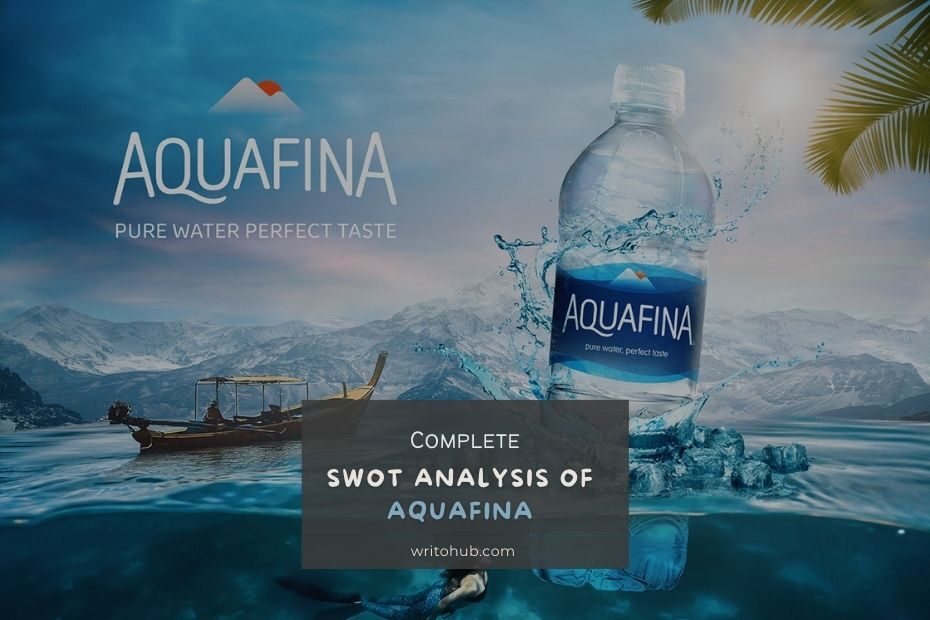Aquafina, a well-known brand in the bottled water industry, operates in a market driven by consumer preferences for clean and convenient hydration.
A SWOT analysis of Aquafina reveals its strengths, weaknesses, opportunities, and threats, offering insights into its strategic position in the dynamic industry.
Strengths in the SWOT Analysis of Aquafina
- Strong Brand Recognition: Aquafina is a globally recognized brand known for its commitment to providing clean and pure drinking water.
- Distribution Network: The brand benefits from an extensive distribution network, ensuring product availability in a wide range of markets and locations.
- Quality Assurance: Aquafina maintains rigorous quality standards and purification processes, assuring consumers of the safety and purity of its water.
- Packaging and Convenience: The brand offers convenient and environmentally friendly packaging that resonates with consumers concerned about sustainability.
- Variety of Sizes: Aquafina provides water in various bottle sizes, catering to different consumer needs, from on-the-go consumption to home use.
Weaknesses in the SWOT Analysis of Aquafina
- Market Competition: The bottled water industry is highly competitive, with numerous brands offering similar products, resulting in pricing pressure and market share challenges.
- Environmental Concerns: The use of plastic bottles generates environmental concerns, particularly related to plastic waste and recycling.
- Price Sensitivity: Some consumers may consider bottled water relatively expensive compared to tap water, leading to potential limitations in price-sensitive segments.
- Perceived Tap Water Quality: In areas with high-quality tap water, consumers may opt for tap water over bottled water, impacting sales.
- Fluctuating Consumer Preferences: Changing consumer preferences, including a shift towards more sustainable options, can affect brand loyalty.
Opportunities in the SWOT Analysis of Aquafina
- Sustainability Initiatives: Addressing environmental concerns by investing in eco-friendly packaging and recycling programs can align with evolving consumer values.
- Product Innovation: Introducing enhanced or value-added water products, such as flavored water or functional water, can open new market segments.
- Health and Wellness Trends: Leveraging the increasing focus on health and wellness can lead to product differentiation and market growth.
- E-commerce Expansion: Leveraging e-commerce and online sales channels can extend Aquafina’s market reach and accessibility to a wider audience.
- International Growth: Exploring opportunities in emerging markets and expanding global operations can diversify revenue sources.
Threats in the SWOT Analysis of Aquafina
- Regulatory Changes: Evolving regulations related to food and beverage packaging, labeling, and safety standards can impact production and compliance costs.
- Economic Downturns: Economic recessions or reduced consumer spending can affect the consumption of bottled water, especially premium brands.
- Competition and Imitation: Competitors and private label brands may imitate Aquafina’s offerings, eroding market share and pricing power.
- Consumer Perception: Negative publicity related to the bottled water industry, such as concerns over water sourcing or the environmental impact, can harm brand reputation.
- Technological Disruption: Advancements in water purification technology or alternatives to bottled water may disrupt the industry.
Conclusion
Aquafina’s SWOT analysis underscores its position as a recognized brand in the bottled water industry.
To maintain and enhance its market presence, Aquafina must leverage its strengths, address weaknesses, seize opportunities, and mitigate threats while adapting to changing consumer preferences, environmental considerations, and competitive dynamics in the bottled water sector.
